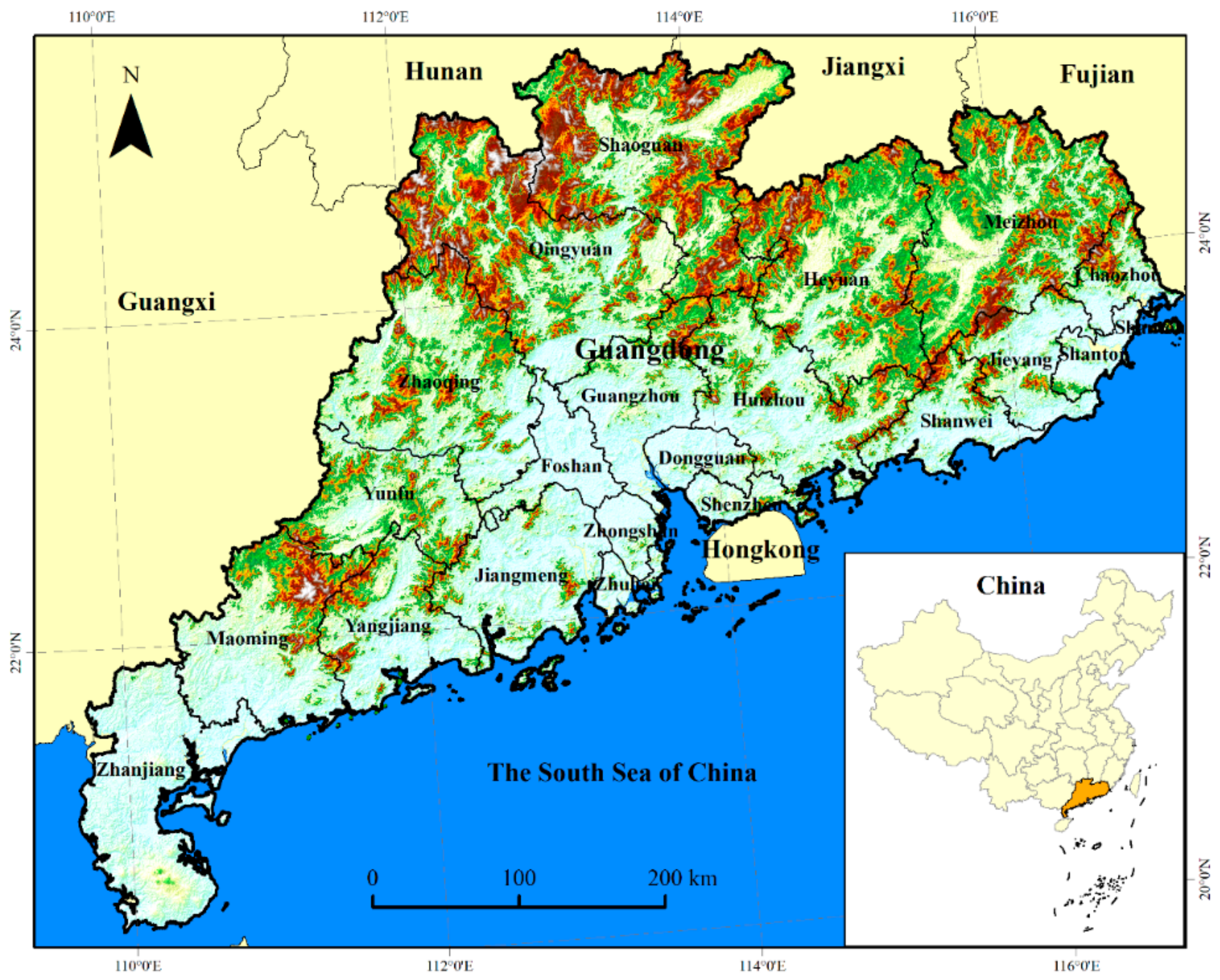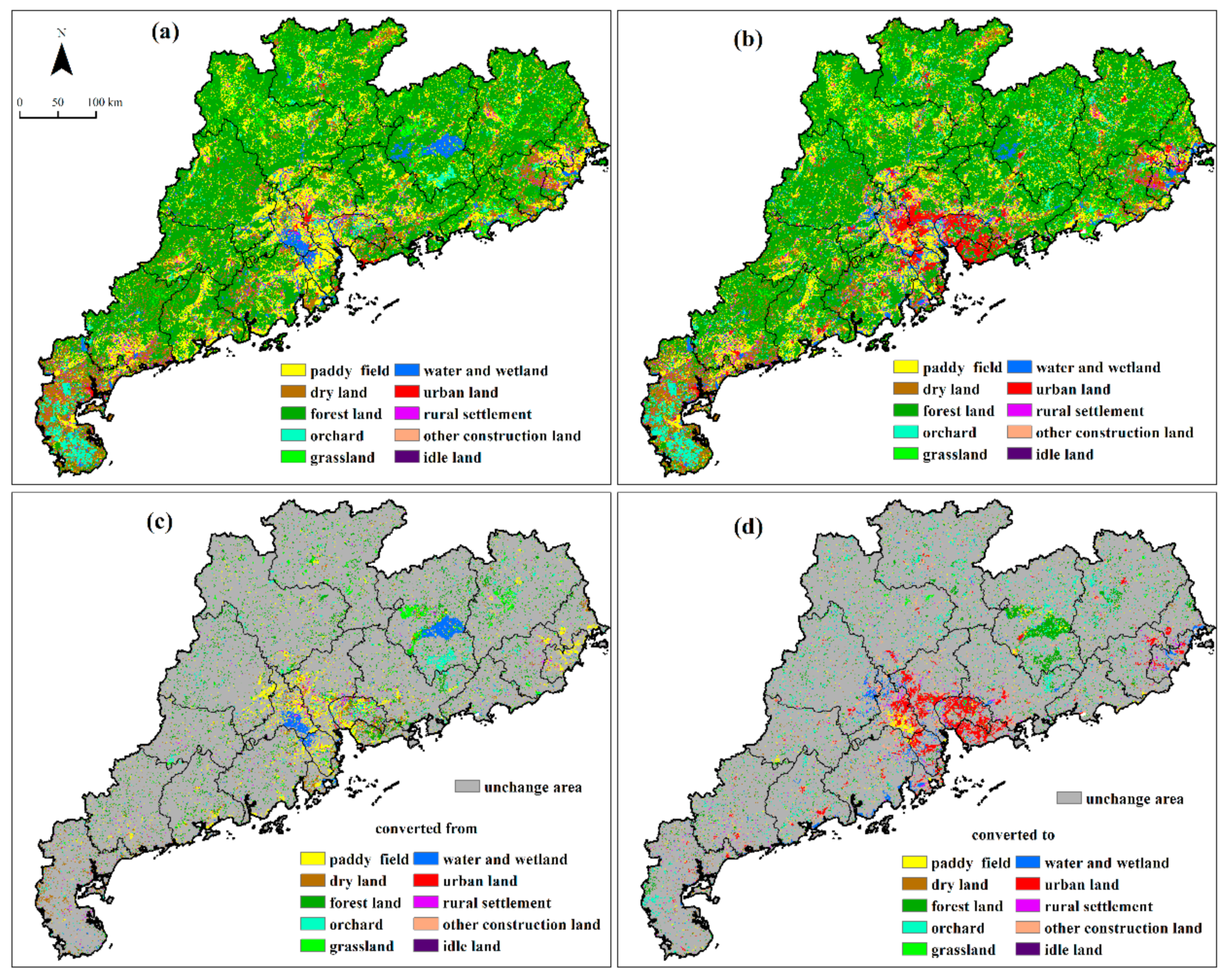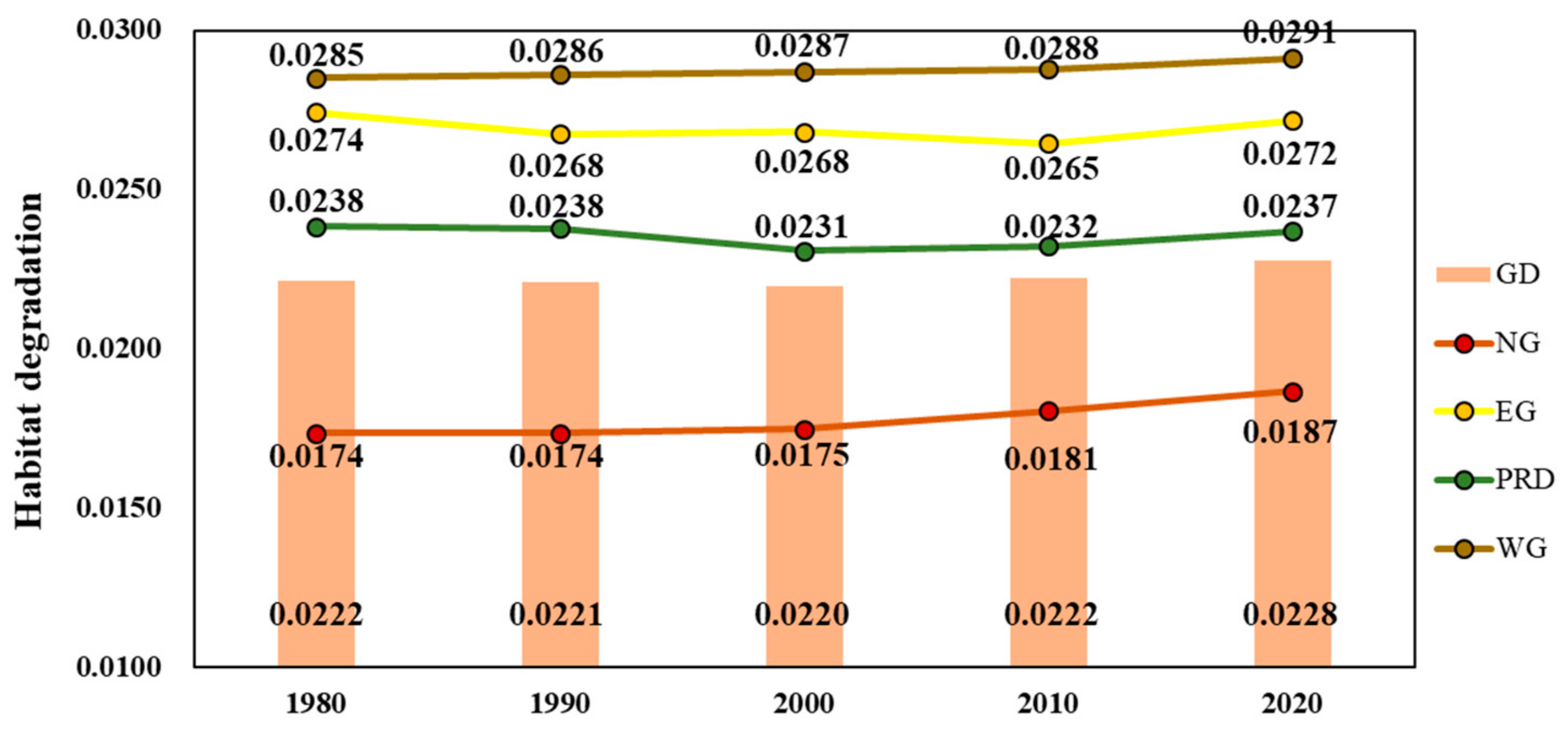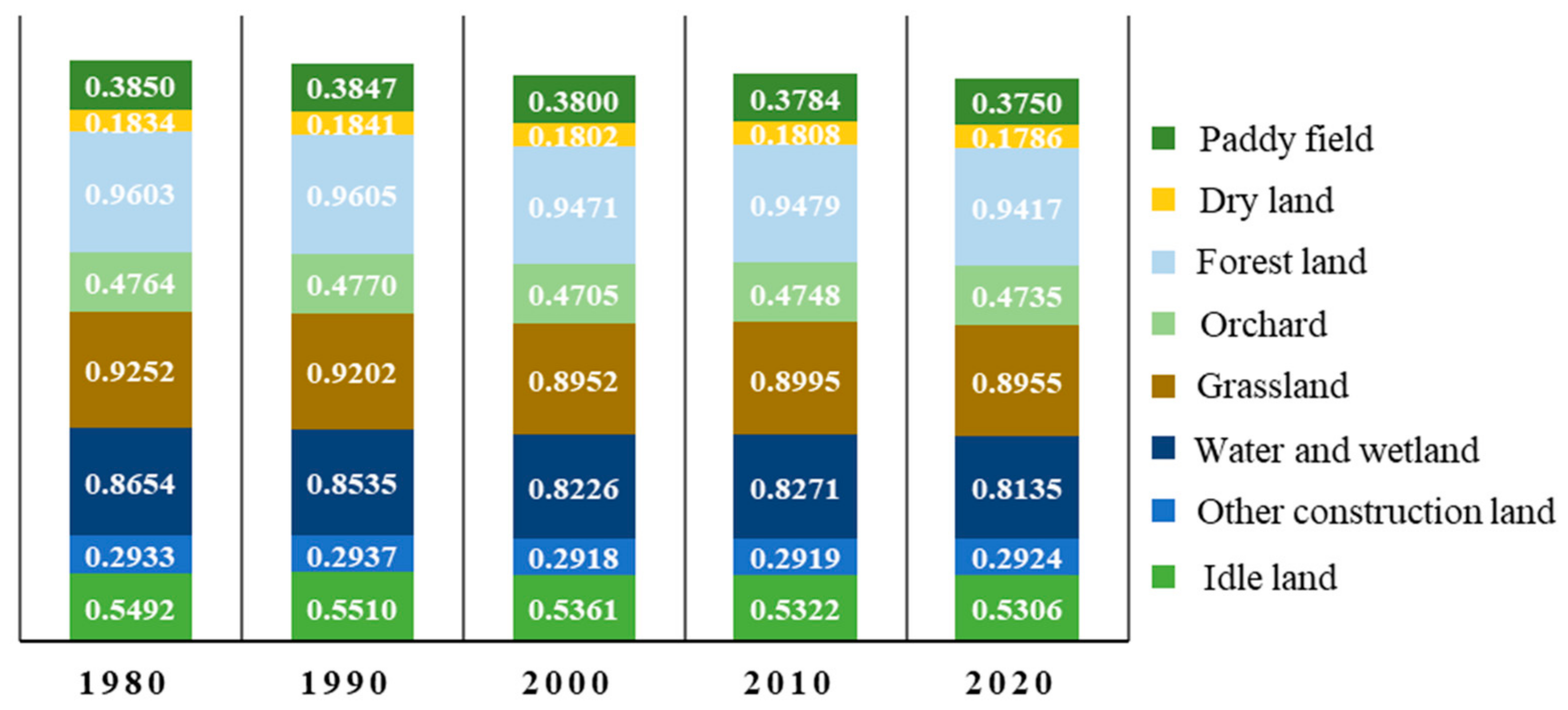Quantifying and Analyzing the Responses of Habitat Quality to Land Use Change in Guangdong Province, China over the Past 40 Years
Abstract
1. Introduction
2. Materials and Methods
2.1. Study Area
2.2. Data Sources
2.3. Study Design
2.4. Methods
2.4.1. Atlas Analysis Method
2.4.2. Habitat Quality Assessment Model
2.4.3. Hotspots Analysis
2.4.4. Assessment of the Contribution of Land Use Change to Habitat Quality
3. Results
3.1. Land Use Change in Guangdong
3.2. Habitat Quality and Degradation
3.2.1. Variation in Habitat Quality
3.2.2. Habitat Degradation
3.3. The Impact of Land Use Change on Habitat Quality
3.3.1. IDIs of Different Land Use Change Types
3.3.2. CIs of Different Land Use Change Types
4. Discussion
4.1. The Verification of Habitat Quality
4.2. Degradation of the Habitat Quality and the Policy Implications
4.3. The Merits and Limitations of This Study
5. Conclusions
Author Contributions
Funding
Institutional Review Board Statement
Informed Consent Statement
Data Availability Statement
Conflicts of Interest
References
- Krausman, P.R. Some basic principles of habitat use. Ida. For. Wildl. Range Exp. Stn. Bull. 1999, 70, 85–90. [Google Scholar]
- Kija, H.K.; Ogutu, J.O.; Mangewa, L.J.; Bukombe, J.; Verones, F.; Graae, B.J.; Kideghesho, J.R.; Said, M.Y.; Nzunda, E.F. Spatio-Temporal Changes in Wildlife Habitat Quality in the Greater Serengeti Ecosystem. Sustainability 2020, 12, 2440. [Google Scholar] [CrossRef]
- Zhang, H.; Zhang, C.; Hu, T.; Zhang, M.; Ren, X.; Hou, L. Exploration of roadway factors and habitat quality using InVEST. Transp. Res. Part D Transp. Environ. 2020, 87, 102551. [Google Scholar] [CrossRef]
- Kunwar, R.M.; Evans, A.; Mainali, J.; Ansari, A.S.; Rimal, B.; Bussmann, R.W. Change in forest and vegetation cover influencing distribution and uses of plants in the Kailash Sacred Landscape, Nepal. Environ. Dev. Sustain. 2020, 22, 1397–1412. [Google Scholar] [CrossRef]
- Ahmadi Mirghaed, F.; Souri, B. Relationships between habitat quality and ecological properties across Ziarat Basin in northern Iran. Environ. Dev. Sustain. 2021, 23, 16192–16207. [Google Scholar] [CrossRef]
- Bai, L.; Xiu, C.; Feng, X.; Liu, D. Influence of urbanization on regional habitat quality: A case study of Changchun City. Habitat Int. 2019, 93, 102042. [Google Scholar] [CrossRef]
- Lee, D.-J.; Jeon, S.W. Estimating Changes in Habitat Quality through Land-Use Predictions: Case Study of Roe Deer (Capreolus pygargus tianschanicus) in Jeju Island. Sustainability 2020, 12, 10123. [Google Scholar] [CrossRef]
- Rybicki, J.; Hanski, I. Speciesarea relationships and extinctions caused by habitat loss and fragmentation. Ecol. Lett. 2013, 16, 27–38. [Google Scholar] [CrossRef]
- Song, C.; Lee, W.-K.; Lim, C.-H.; Jeon, S.W.; Kim, J. Habitat Quality Valuation Using InVEST Model in Jeju Island. J. Korea Soc. Environ. Restor. Technol. 2015, 18, 1–11. [Google Scholar] [CrossRef]
- Janus, J.; Bozek, P. Land abandonment in Poland after the collapse of socialism: Over a quarter of a century of increasing tree cover on agricultural land. Ecol. Eng. 2019, 138, 106–117. [Google Scholar] [CrossRef]
- Sharma, R.; Nehren, U.; Rahman, S.; Meyer, M.; Rimal, B.; Aria Seta, G.; Baral, H. Modeling Land Use and Land Cover Changes and Their Effects on Biodiversity in Central Kalimantan, Indonesia. Land 2018, 7, 57. [Google Scholar] [CrossRef]
- Gao, Y.; Ma, L.; Liu, J.; Zhuang, Z.; Huang, Q.; Li, M. Constructing Ecological Networks Based on Habitat Quality Assessment: A Case Study of Changzhou, China. Sci. Rep. 2017, 7, 46073. [Google Scholar] [CrossRef] [PubMed]
- Guo, Z.W.; Zhang, L.; Li, Y.M. Increased Dependence of Humans on Ecosystem Services and Biodiversity. PLoS ONE 2010, 5, e13113. [Google Scholar] [CrossRef] [PubMed]
- Liu, Y.; Huang, X.J.; Yang, H.; Zhong, T.Y. Environmental effects of land-use/cover change caused by urbanization and policies in Southwest China Karst area A case study of Guiyang. Habitat Int. 2014, 44, 339–348. [Google Scholar] [CrossRef]
- Ding, Q.; Chen, Y.; Bu, L.; Ye, Y. Multi-Scenario Analysis of Habitat Quality in the Yellow River Delta by Coupling FLUS with InVEST Model. Int. J. Environ. Res. Public Health 2021, 18, 2389. [Google Scholar] [CrossRef]
- Newbold, T.; Hudson, L.N.; Hill, S.L.L.; Contu, S.; Lysenko, I.; Senior, R.A.; Boerger, L.; Bennett, D.J.; Choimes, A.; Collen, B.; et al. Global effects of land use on local terrestrial biodiversity. Nature 2015, 520, 45–50. [Google Scholar] [CrossRef]
- Ramaswami, A. Unpacking the Urban Infrastructure Nexus with Environment, Health, Livability, Well-Being, and Equity Comment. One Earth 2020, 2, 120–124. [Google Scholar] [CrossRef]
- Wang, H.; Tang, L.; Qiu, Q.; Chen, H. Assessing the Impacts of Urban Expansion on Habitat Quality by Combining the Concepts of Land Use, Landscape, and Habitat in Two Urban Agglomerations in China. Sustainability 2020, 12, 4346. [Google Scholar] [CrossRef]
- Du, Y.; Qin, W.; Sun, J.; Wang, X.; Gu, H. Spatial Pattern and Influencing Factors of Regional Ecological Civilisation Construction in China. Chin. Geogr. Sci. 2020, 30, 776–790. [Google Scholar] [CrossRef]
- Gai, M.; Wang, X.; Qi, C. Spatiotemporal Evolution and Influencing Factors of Ecological Civilization Construction in China. Complexity 2020, 2020, 8829144. [Google Scholar] [CrossRef]
- Ye, Y.; Li, S.; Zhang, H.; Su, Y.; Wu, Q.; Wang, C. Spatial-Temporal Dynamics of the Economic Efficiency of Construction Land in the Pearl River Delta Megalopolis from 1998 to 2012. Sustainability 2017, 10, 63. [Google Scholar] [CrossRef]
- Ye, Y.; Zhang, J.; Wang, T.; Bai, H.; Wang, X.; Zhao, W. Changes in Land-Use and Ecosystem Service Value in Guangdong Province, Southern China, from 1990 to 2018. Land 2021, 10, 426. [Google Scholar] [CrossRef]
- Li, C.; Kuang, Y.; Huang, N.; Zhang, C. The long-term relationship between population growth and vegetation cover: An empirical analysis based on the panel data of 21 cities in Guangdong Province, China. Int. J. Environ. Res. Public Health 2013, 10, 660–677. [Google Scholar] [CrossRef] [PubMed]
- National Bureau of Statistics of China. China Statistical Yearbook; China Statistics Press: Beijing, China, 2021. [Google Scholar]
- Statistics Bureau of Guangdong Province. Guangdong Statistical Yearbook; China Statistics Press: Beijing, China, 2021. [Google Scholar]
- Xu, F.; Wang, Z.; Chi, G.; Zhang, Z. The impacts of population and agglomeration development on land use intensity: New evidence behind urbanization in China. Land Use Policy 2020, 95, 104639. [Google Scholar] [CrossRef]
- Liu, J.; Ning, J.; Kuang, W.; Xu, X.; Zhang, S.; Yan, C.; Li, R.; Wu, S.; Hu, Y.; Du, G.; et al. Spatio-temporal patterns and characteristics of land-use change in China during 2010–2015. Acta Geogr. Sin. 2018, 28, 16. [Google Scholar]
- Seto, K.C.; Fragkias, M.; Gueneralp, B.; Reilly, M.K. A Meta-Analysis of Global Urban Land Expansion. PLoS ONE 2011, 6, e23777. [Google Scholar] [CrossRef] [PubMed]
- Song, M.; Wu, Y.; Chen, L. Does the land titling program promote rural housing land transfer in China? Evidence from household surveys in Hubei Province. Land Use Policy 2020, 97, 104701. [Google Scholar] [CrossRef]
- Lai, Y.; Huang, G.; Chen, S.; Lin, S.; Lin, W.; Lyu, J. Land Use Dynamics and Optimization from 2000 to 2020 in East Guangdong Province, China. Sustainability 2021, 13, 3473. [Google Scholar] [CrossRef]
- Ren, H.; Chen, H.; Li, L.; Li, P.; Hou, C.; Wan, H.; Zhang, Q.; Zhang, P. Spatial and temporal patterns of carbon storage from 1992 to 2002 in forest ecosystems in Guangdong, Southern China. Plant Soil 2013, 363, 123–138. [Google Scholar] [CrossRef]
- Department of Water Resources of Guangdong Province. Bulletin of Soil and Water Conservation of Guangdong Province; Department of Water Resources of Guangdong Province: Guangzhou, China, 2020. [Google Scholar]
- Fan, X.; Gu, X.; Yu, H.; Long, A.; Tiando, D.S.; Ou, S.; Li, J.; Rong, Y.; Tang, G.; Zheng, Y.; et al. The Spatial and Temporal Evolution and Drivers of Habitat Quality in the Hung River Valley. Land 2021, 10, 1369. [Google Scholar] [CrossRef]
- Huang, J.; Tang, Z.; Liu, D.; He, J. Ecological response to urban development in a changing socio-economic and climate context: Policy implications for balancing regional development and habitat conservation. Land Use Policy 2020, 97, 104772. [Google Scholar] [CrossRef]
- Wu, L.; Sun, C.; Fan, F. Estimating the Characteristic Spatiotemporal Variation in Habitat Quality Using the InVEST Model—A Case Study from Guangdong–Hong Kong–Macao Greater Bay Area. Remote Sens. 2021, 13, 1008. [Google Scholar] [CrossRef]
- Verheyen, H.K. Legacies of the past in the present-day forest biodiversity: A review of past land-use effects on forest plant species composition and diversity. Ecol. Res. 2007, 22, 361–371. [Google Scholar]
- Han, Y.; Kang, W.; Thorne, J.; Song, Y. Modeling the effects of landscape patterns of current forests on the habitat quality of historical remnants in a highly urbanized area. Urban For. Urban Green. 2019, 41, 354–363. [Google Scholar] [CrossRef]
- Mengist, W.; Soromessa, T.; Feyisa, G.L. Landscape change effects on habitat quality in a forest biosphere reserve: Implications for the conservation of native habitats. J. Clean. Prod. 2021, 329, 129778. [Google Scholar] [CrossRef]
- Sieber, A.; Uvarov, N.V.; Baskin, L.M.; Radeloff, V.C.; Bateman, B.L.; Pankov, A.B.; Kuemmerle, T. Post-Soviet land-use change effects on large mammals’ habitat in European Russia. Biol. Conserv. 2015, 191, 567–576. [Google Scholar] [CrossRef]
- Yang, J.; Li, S.; Lu, H. Quantitative Influence of Land-Use Changes and Urban Expansion Intensity on Landscape Pattern in Qingdao, China: Implications for Urban Sustainability. Sustainability 2019, 11, 6174. [Google Scholar] [CrossRef]
- Berta Aneseyee, A.; Noszczyk, T.; Soromessa, T.; Elias, E. The InVEST Habitat Quality Model Associated with Land Use/Cover Changes: A Qualitative Case Study of the Winike Watershed in the Omo-Gibe Basin, Southwest Ethiopia. Remote Sens. 2020, 12, 1103. [Google Scholar] [CrossRef]
- Song, S.; Liu, Z.; He, C.; Lu, W. Evaluating the effects of urban expansion on natural habitat quality by coupling localized shared socioeconomic pathways and the land use scenario dynamics-urban model. Ecol. Indic. 2020, 112, 106071. [Google Scholar] [CrossRef]
- Nie, C.; Yang, J.; Huang, C. Assessing the Habitat Quality of Aquatic Environments in Urban Beijing. Procedia Environ. Sci. 2016, 36, 162–168. [Google Scholar] [CrossRef]
- Santelmann, M.; Freemark, K.; Sifneos, J.; White, D. Assessing effects of alternative agricultural practices on wildlife habitat in Iowa, USA. Agric. Ecosyst. Environ. 2006, 113, 243–253. [Google Scholar] [CrossRef]
- Sallustio, L.; De Toni, A.; Strollo, A.; Di Febbraro, M.; Gissi, E.; Casella, L.; Geneletti, D.; Munafo, M.; Vizzarri, M.; Marchetti, M. Assessing habitat quality in relation to the spatial distribution of protected areas in Italy. J. Environ. Manag. 2017, 201, 129–137. [Google Scholar] [CrossRef] [PubMed]
- Zhang, X.; Song, W.; Lang, Y.; Feng, X.; Yuan, Q.; Wang, J. Land use changes in the coastal zone of China’s Hebei Province and the corresponding impacts on habitat quality. Land Use Policy 2020, 99, 104957. [Google Scholar] [CrossRef]
- He, J.; Huang, J.; Li, C. The evaluation for the impact of land use change on habitat quality: A joint contribution of cellular automata scenario simulation and habitat quality assessment model. Ecol. Model. 2017, 366, 58–67. [Google Scholar] [CrossRef]
- Li, F.; Wang, L.; Chen, Z.; Clarke, K.C.; Li, M.; Jiang, P. Extending the SLEUTH model to integrate habitat quality into urban growth simulation. J. Environ. Manag. 2018, 217, 486–498. [Google Scholar] [CrossRef] [PubMed]
- Tang, F.; Fu, M.; Wang, L.; Zhang, P. Land-use change in Changli County, China: Predicting its spatio-temporal evolution in habitat quality. Ecol. Indic. 2020, 117, 106719. [Google Scholar] [CrossRef]
- Moreira, M.; Fonseca, C.; Vergílio, M.; Calado, H.; Gil, A. Spatial assessment of habitat conservation status in a Macaronesian island based on the InVEST model: A case study of Pico Island (Azores, Portugal). Land Use Policy 2018, 78, 637–649. [Google Scholar] [CrossRef]
- De Simone, S.; Sigura, M.; Boscutti, F. Patterns of biodiversity and habitat sensitivity in agricultural landscapes. J. Environ. Plan. Manag. 2017, 60, 1173–1192. [Google Scholar] [CrossRef]
- Li, M.; Zhou, Y.; Xiao, P.; Tian, Y.; Huang, H.; Xiao, L. Evolution of Habitat Quality and Its Topographic Gradient Effect in Northwest Hubei Province from 2000 to 2020 Based on the InVEST Model. Land 2021, 10, 857. [Google Scholar] [CrossRef]
- Polasky, S.; Nelson, E.; Pennington, D.; Johnson, K.A. The Impact of Land-Use Change on Ecosystem Services, Biodiversity and Returns to Landowners: A Case Study in the State of Minnesota. Environ. Resour. Econ. 2011, 48, 219–242. [Google Scholar] [CrossRef]
- Shobairi, S.O.R.; Li, M. Dynamic Modelling of VFC from 2000 to 2010 Using NDVI and DMSP/OLS Time Series: A Study in Guangdong Province, China. J. Geogr. Inf. Syst. 2016, 08, 205–223. [Google Scholar] [CrossRef][Green Version]
- Zheng, J.Y.; Yin, Y.H.; Li, B.Y. A new scheme for climate regionalization in China. Acta Geogr. Sin. 2010, 65, 3–12. [Google Scholar]
- Kuang, W.; Liu, J.; Dong, J.; Chi, W.; Zhang, C. The rapid and massive urban and industrial land expansions in China between 1990 and 2010: A CLUD-based analysis of their trajectories, patterns, and drivers. Landsc. Urban Plan. 2016, 145, 21–33. [Google Scholar] [CrossRef]
- Liu, J.; Liu, M.; Deng, X.; Zhuang, D.; Zhang, Z.; Luo, D. The land use and land cover change database and its relative studies in China. J. Geogr. Sci. 2002, 12, 275–282. [Google Scholar]
- Jia, N.; Liu, J.; Kuang, W.; Xu, X.; Jing, N. Spatiotemporal patterns and characteristics of land-use change in China during 2010–2015. J. Geogr. Sci. 2018, 28, 547–562. [Google Scholar]
- Tallis, H. Natural Capital: Theory and Practice of Mapping Ecosystem Services; Oxford University Press: Oxford, UK, 2011. [Google Scholar]
- Sharp, R.; Chaplin-Kramer, R.; Wood, S.; Guerry, A.; Douglass, J. InVEST User’s Guide; Stanford University: Stanford, CA, USA; University of Minnesota: Minneapolis, MN, USA; The Nature Conservancy: Arlington, VA, USA; World Wildlife Fund: Minneapolis, MN, USA, 2018. [Google Scholar]
- Zhang, H.B.; Wu, F.E.; Zhang, Y.N.; Han, S.; Liu, Y.Q. Spatial and temporal changes of habitat quality in Jiangsu Yancheng wetland national nature reserve—Rare birds of China. Appl. Ecol. Environ. Res. 2019, 17, 4807–4821. [Google Scholar] [CrossRef]
- Zhang, L.; Hu, N. Spatial Variation and Terrain Gradient Effect of Ecosystem Services in Heihe River Basin over the Past 20 Years. Sustainability 2021, 13, 11271. [Google Scholar] [CrossRef]
- Wu, J.; Li, X.; Luo, Y.; Zhang, D. Spatiotemporal Effects of Urban Sprawl on Habitat Quality in the Pearl River Delta from 1990 to 2018. Sci. Rep. 2021, 11, 13981. [Google Scholar] [CrossRef]
- Liu, H.; Lin, M.; Zhou, R.; Zhong, L. Spatial and temporal evolution of habitat quality in Guangdong-Hong Kong-Macao Greater Bay Area based on InVEST model. Ecol. Sci. 2021, 40, 82–91. (In Chinese) [Google Scholar]
- Jiang, W.; Wu, J. Spatio-temporal evolution of habitat quality in Guangdong-Hong Kong-Macao Greater Bay Area based on regional GDP and population spatial distribution. Acta Ecol. Sin. 2021, 41, 1747–1757. [Google Scholar]
- Chen, C.; Zhang, Q.; Yang, X.; Li, R.; Xin, C. Habitat Quality Assessment of Waterfowl Ecological Corridors in the Pearl River Delta Based on InVEST Model. For. Environ. Sci. 2021, 37, 25–30. (In Chinese) [Google Scholar]
- Lu, Y.; Li, T.; Gong, J. Attribution of habitat quality in different geomorphological types in Guangdong Province. Ecol. Sci. 2022, 41, 24–32. (In Chinese) [Google Scholar]










| Threat Factor | Maximum Threat Distance (km) | Weight | Decay |
|---|---|---|---|
| Paddy field | 4 | 0.7 | linear |
| Dry land | 3 | 0.6 | linear |
| Orchard | 3 | 0.5 | linear |
| Urban land | 10 | 0.3 | exponential |
| Rural settlements | 5 | 0.2 | exponential |
| Other construction land | 4 | 0.6 | exponential |
| Idle land | 6 | 0.5 | linear |
| Habitat Type | Habitat | PF | DL | ORC | UL | RS | OCL | IL |
|---|---|---|---|---|---|---|---|---|
| PF | 0.4 | 0 | 1 | 0.3 | 0.8 | 0.7 | 0.8 | 0.4 |
| DL | 0.2 | 1 | 0 | 0.2 | 0.8 | 0.6 | 0.9 | 0.5 |
| FL | 1 | 0.6 | 0.7 | 0.5 | 0.3 | 0.4 | 0.5 | 0.2 |
| ORC | 0.5 | 0.3 | 0.5 | 0 | 0.5 | 0.6 | 0.7 | 0.3 |
| GL | 1 | 0.6 | 0.7 | 0.5 | 0.6 | 0.5 | 0.4 | 0.6 |
| W&W | 1 | 0.7 | 0.5 | 0.3 | 0.5 | 0.4 | 0.4 | 0.3 |
| UL | 0 | 0.05 | 0.1 | 0.1 | 0 | 0 | 0.1 | 0.1 |
| RS | 0 | 0.7 | 0.7 | 0.5 | 0 | 0 | 0.9 | 0.1 |
| OCL | 0.3 | 0.2 | 0.2 | 0.3 | 0.4 | 0.5 | 0 | 0 |
| IL | 0.6 | 0.5 | 0.55 | 0.6 | 0.3 | 0.35 | 0.6 | 0 |
| After Convert | |||||||||||
|---|---|---|---|---|---|---|---|---|---|---|---|
| PF | DL | FL | ORC | GL | W&W | UL | RS | OCL | IL | ||
| Before convert | PF | - | −0.0158 | 0.0504 | 0.0101 | 0.0441 | 0.0396 | −0.0378 | −0.0380 | −0.0091 | 0.0122 |
| DL | 0.0137 | - | 0.0670 | 0.0263 | 0.0621 | 0.0665 | −0.0172 | −0.0175 | 0.0120 | 0.0358 | |
| FL | −0.0523 | −0.0701 | - | −0.0461 | −0.0007 | 0.0000 | −0.0903 | −0.0811 | −0.0590 | −0.0300 | |
| ORC | −0.0126 | −0.0251 | 0.0448 | - | 0.0413 | 0.0369 | −0.0462 | −0.0468 | −0.0174 | - | |
| GL | −0.0466 | −0.0657 | −0.0005 | −0.0406 | - | −0.0011 | −0.0858 | −0.0808 | −0.0542 | −0.0355 | |
| W&W | −0.0436 | −0.0638 | −0.0020 | −0.0318 | −0.0012 | - | −0.0870 | −0.0833 | −0.0555 | −0.0392 | |
| UL | 0.0375 | 0.0167 | 0.0924 | 0.0449 | 0.0949 | 0.0917 | - | 0.0000 | 0.0294 | - | |
| RS | 0.0379 | 0.0178 | 0.0866 | 0.0452 | 0.0793 | 0.0770 | 0.0000 | - | 0.0290 | 0.0582 | |
| OCL | 0.0093 | −0.0111 | 0.0577 | 0.0181 | 0.0506 | 0.0556 | −0.0294 | −0.0292 | - | - | |
| IL | −0.0128 | −0.0343 | 0.0252 | −0.0063 | 0.0386 | 0.0386 | - | −0.0570 | −0.0228 | - | |
| 2020 | |||||||||||
|---|---|---|---|---|---|---|---|---|---|---|---|
| PF | DL | FL | ORC | GL | W&W | UA | RS | OCL | IL | ||
| 1980 | PF | - | −0.54 | 7.79 | 0.32 | 0.88 | 8.31 | −11.67 | −3.52 | −1.31 | 0.00 |
| DL | 0.46 | - | 8.98 | 1.44 | 0.83 | 2.42 | −2.21 | −0.68 | 0.84 | 0.01 | |
| FL | −7.50 | −8.04 | - | −24.09 | −0.09 | 0.00 | −7.47 | −1.33 | −7.66 | −0.03 | |
| ORC | −0.26 | −0.26 | 9.53 | - | 0.32 | 0.36 | −1.50 | −0.22 | −0.34 | - | |
| GL | −1.64 | −1.43 | −0.11 | −1.76 | - | −0.01 | −1.26 | −0.29 | −1.50 | −0.01 | |
| W&W | −3.85 | −0.73 | −0.29 | −0.66 | −0.01 | - | −4.45 | −0.72 | −2.33 | −0.03 | |
| UA | 0.05 | 0.02 | 0.29 | 0.03 | 0.00 | 0.20 | - | 0.00 | 0.09 | - | |
| RS | 1.59 | 0.45 | 1.13 | 0.13 | 0.26 | 0.48 | 0.00 | - | 0.27 | 0.02 | |
| OCL | 0.03 | −0.03 | 0.16 | 0.02 | 0.02 | 0.40 | −0.39 | −0.06 | - | - | |
| IL | 0.00 | −0.01 | 0.02 | −0.01 | 0.05 | 0.02 | - | 0.00 | −0.05 | - | |
| Sub-Region | Positive Contribution | Negative Contribution | ||||
|---|---|---|---|---|---|---|
| Total CI | Main Converted Types and Their CIs | Total CI | Main Converted Types and Their CIs | |||
| NG | 4.2326 | PF ct FL | 4.38 | −8.1772 | FL ct PF | −4.38 |
| PF ct W&W | 0.53 | FL ct DL | −2.75 | |||
| DL ct FL | 2.55 | FL ct ORC | −14.03 | |||
| ORC ct FL | 5.97 | FL ct OCL | −2.54 | |||
| EG | 1.1185 | PF ct FL | 0.40 | −1.8485 | PF ct UL | −1.30 |
| PF ct W&W | 1.24 | PF ct RS | −0.59 | |||
| DL ct FL | 1.07 | FL ct DL | −0.94 | |||
| ORC ct FL | 0.58 | FL ct ORC | −1.25 | |||
| PRD | 4.2622 | PF ct FL | 1.99 | −12.3288 | PF ct UL | −9.02 |
| PF ct W&W | 5.94 | FL ct ORC | −6.23 | |||
| DL ct FL | 1.92 | FL ct UL | −6.73 | |||
| ORC ct FL | 2.29 | W&W ct UL | −4.22 | |||
| WG | 2.4460 | PF ct FL | 1.03 | −2.7286 | FL ct PF | −1.02 |
| DL ct FL | 3.44 | FL ct DL | −2.50 | |||
| DL ct ORC | 1.06 | FL ct ORC | −2.58 | |||
| DL ct W&W | 0.80 | FLct OCL | −0.76 | |||
| Region | Threat Factors | Results | Comparison |
|---|---|---|---|
| Guangdong–Hong Kong–Macao Greater Bay Area (GBA) | Bare land, Built-up areas, Cropland, Railway, Trunk road, Primary road, Secondary road, Industry activity, Residential [35]. |
|
|
| Cultivate land, Construction land, and Idle land [64]. |
|
| |
| Paddy field, Upland field, Urban land, Rural settlement, Construction land, Sand, Bare ground [65]. |
|
| |
| Pearl River Delta (PRD) | Construction land, Idle land [66]. |
|
|
| Cropland, City/town, Rural settlements, Other construction land, Unused land, Land reclamation [63]. |
|
| |
| Guangdong Province | Cultivate land, Construction land, and Idle land [67]. |
|
|
Publisher’s Note: MDPI stays neutral with regard to jurisdictional claims in published maps and institutional affiliations. |
© 2022 by the authors. Licensee MDPI, Basel, Switzerland. This article is an open access article distributed under the terms and conditions of the Creative Commons Attribution (CC BY) license (https://creativecommons.org/licenses/by/4.0/).
Share and Cite
Zhang, H.; Lang, Y. Quantifying and Analyzing the Responses of Habitat Quality to Land Use Change in Guangdong Province, China over the Past 40 Years. Land 2022, 11, 817. https://doi.org/10.3390/land11060817
Zhang H, Lang Y. Quantifying and Analyzing the Responses of Habitat Quality to Land Use Change in Guangdong Province, China over the Past 40 Years. Land. 2022; 11(6):817. https://doi.org/10.3390/land11060817
Chicago/Turabian StyleZhang, Hanwen, and Yanqing Lang. 2022. "Quantifying and Analyzing the Responses of Habitat Quality to Land Use Change in Guangdong Province, China over the Past 40 Years" Land 11, no. 6: 817. https://doi.org/10.3390/land11060817
APA StyleZhang, H., & Lang, Y. (2022). Quantifying and Analyzing the Responses of Habitat Quality to Land Use Change in Guangdong Province, China over the Past 40 Years. Land, 11(6), 817. https://doi.org/10.3390/land11060817






